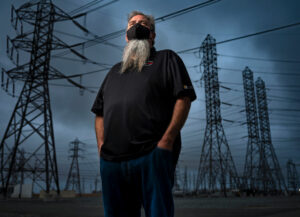No sooner does California move to ban the sale of gasoline-powered cars by 2035 and force everyone to buy electric cars than it announces, oh by the way, please don’t charge your electric cars last weekend because we’re going to be short of power as three-digit temperatures strain the grid. And turn your thermostats up to 78 while you’re at it.
Perhaps California will have figured out a way of expanding its carbon-free electricity sources and grid capacity in the next decade, and the recent week’s lopsided vote in the state legislature to keep open its Diablo Canyon nuclear power plant, which supplies nearly 10 percent of California total electricity at present, is a sign that energy reality is starting to intrude. But even if the dreams of a “carbon-free” California somehow come true over the next two decades, the electric car diktat represents a stark new moment in our green madness.

Gavin Newsom: now hear this, peasants.
Never mind that the electric car mandate was promulgated not by the elected state legislature, but by the eco-crats at the California Air Resources Board (CARB), representing yet another example of the administrative state in action. And never mind that the lifecycle environmental impacts (including carbon emissions) of the vast supply-chain for electric cars and their material-intensive batteries are nearly as large as conventional hydrocarbon vehicle. The strangest aspect of the scene is that the biggest enthusiasts for the electric car mandate are America’s auto manufacturers.
Barron’s magazine reported last month: The Biggest Fans of California’s No-Gas Policy? Ford and GM. “General Motors and California have a shared vision of an all-electric future,” said GM’s spokesperson Elizabeth Winter. “We’re proud of our partnership with California,” Ford’s “chief sustainability officer,” Bob Holycross, said in a statement. In Detroit-speak, “partnership” is today’s patois for “take orders from the government.” It was fashionable after the automakers were bailed out in 2009 to refer to GM as “Government Motors,” but today the label truly fits. The political takeover of the auto industry, long in the making, is now complete.
One way to perceive this slow-motion takeover more clearly is to ask why cars from every automaker now look the same. Most cars models now are squat, with teardrop-shaped bodies, nearly interchangeable with models from other manufacturers. Even high-end SUVs like the Ford Explorer or Range Rover are shorter and rounder than their predecessor models of just a few years ago. This is likely not a response to changing taste in car buyers, like tail fins in the late 1950s. A primary driver of current design are aerodynamic requirements to help meet the government-mandated fleet fuel-economy standards that have been slowly ratcheted up over the last decade.
Some years ago I met in Washington with senior executives from one of the big-three Detroit automakers to talk about energy and environmental policy, and how it affected their industry. They said that their single biggest problem in planning for the future was less the uncertainty of government regulation than wildly fluctuating gasoline prices. If car makers could predict what gasoline prices would be over the next decade, they’d know what kind of cars to build. When gas prices are low, consumers like SUVs; when gas prices are high, they shift on a dime to smaller, higher mileage cars. Car companies may see a shift to an all-electric car fleet as a means to ending the boom-and-bust cycle that has afflicted the industry for decades. Never mind that electricity rates are likely to become more volatile as we “green” the supply, as Europe is learning to its chagrin right now. And Californians already pay twice as much for electricity as the national average.

Pray it keeps working.
Beyond the final submission of the auto companies to our green commissars, there are a number of other ways California’s electric car mandate represents a step increase in the ambition of the climate crusaders. California has long enjoyed the privilege under federal law of setting its own tailpipe emissions standards for autos sold in the state that were tougher than national standards (a power the Trump Administration sought to curtail—and a lawsuit remains in process). Because auto makers didn’t want to manufacture two different kinds of cars (or surrender the California market), the California standard effectively became the national standard.
It’s one thing to impose a product performance standard; it’s another thing to ban a product that would be legal in the other 49 states. This may run afoul of the Commerce Clause of the Constitution, especially if California prohibits bringing gasoline-powered cars into the state. One can imagine a market for gasoline-powered cars sold just over state lines, and delivered to California buyers by Carvana or some other enterprise. Will the state attempt to “retire” the existing gasoline-powered vehicles in the state and close down gas stations? Look for a flourishing black market for gas and diesel. And the next wave of demand for H1B visas will be for Cuban auto mechanics, who are skilled in keeping gasoline-powered cars running for decades.
As it did with emissions standards, California likely thinks it can strong-arm other states or Congress to adopt its electric-car mandate. Texas (among other states) might have something to say about that. And what if car companies and consumers don’t go along with this extravagant target? The New York Times reported a crucial caveat:
To enforce its rule . . . California would fine automakers up to $20,000 for every car that falls short of production targets. The state also could propose new amendments revising the sales targets if the market doesn’t react as state leaders hope, said Jennifer Gress, who leads the California air board’s sustainable transportation division. [Emphasis added.]

Cuban mechanics wanted.
That language about “amendments” is the Emily Litella “never mind” clause. It has happened before. In a prequel to the current madness, in the early 1990s California tried to mandate that 5 percent of all new cars sold by the year 2001 be emission-free, which meant electric cars in practice. GM publicized lots of happy talk about its EV-1, a crappy electric car that cost six-figures (though it was “leased” at an implied purchase price of about $35,000), had a pathetically short range (50 miles on a good day), and took several hours to recharge. Not long before the mandate was set to take effect, it was quietly abandoned.
Electric cars have gotten much better in recent years, but in a state where lots of drivers travel well beyond the range of an electric vehicle every day, EVs still won’t meet the needs of a large number of Californians—never mind citizens of rural states that need vehicles that can run all day long. Look for history to repeat itself with the California EV mandate.
Article tags: California, Detroit, electric cars, EVs, Ford, Gas and oil, gasoline vehicles, Gavin Newsom, GM, green energy, greenhouse gases
Newsom is a Pinhead and Biden is a Idiot they want all of America to reyle upon Wind and Solar Power like they did in Texas
As I was telling HL Mencken a few decades ago, people need to get everything they vote for, in spades, good and hard, until it grinds them to powder.
The mandates to eliminate ICE vehicles is the entire game, period. Gang green and the WEF have no appetite for the doubling of the grid just for EVs and doubling again for net zero with nuclear power (the only system capable of self replication). The energy involved in such a transition would guarantee the extensive use of all fossil fuels available for decades. The central planners have always wanted to eliminate the era of the personal automobile and this is their chance. Only high ranking party members and select few with high social credit scores will be allowed to own EVs. The auto industry being the rent seeking, useful idiots they are will be surprised with the end game finale. The only question is does this path originate from delusion and ignorance or by despotic direction.
Did nt Tom Quinn, who created the California Air Resources Board in its current form, a rich kid who was Gerry Browns campaign manager in 1974, say quite explicitly that one of the goals of CARB was to some day to ban almost all private automobiles and force everyone to use public transit. With the rich people like him owning electric (or hydrogen) cars.
Which is the policy CARB has followed since the 1970's. Got little to do with reducing pollution. In fact CARB regulations have been responsible for some of the states worst ecological disasters of the last 50 years. Water tables poisoned by MTBE in several counties. A huge increase in wildfires due to CARB rules which made wildfire control measure almost impossible. And so on.
The rich and the privileged will have their electric vehicles. The poor and middle class will take the train and like it.
Enron
Won't happen. The push for EV's has nothing to do with the climate "crisis". It's a vehicle (no pun) for the WEF/ Davos types to increase dependency, and keeping mobility to a small radius. It's about power and control.
Germany electric prices.
Close, Steve, but I don't think electric rates are ever going to be volatile, as with gas prices. OPEC can't influence your KwH rate. Prices will be moving, but only in one direction. The car-maker's unholy alliance with California, by the way, isn't too different from Big Utility getting in bed with the "sustainable" nutcakes, because building those green projects is one way to make big money they can't make building fossil-fuel burners.
Behind the scenes companies are being "blackmailed" by BlackRock's ESG program. The ESG dictat is being used by BlackRock and its cohorts to sidestep the law and force the ESG ideology on companies, i.e. sacrificing investor returns for political returns. Plus many of the players are members of the WEF Davos crowd who IMO are fascist depopulation organizations. Newsome is a WEF member too.
I've seen some regressive policies in the past that affected lower-income families heavily, but this one takes the cake. The rich will get their electric vehicles, but poorer working class people will be out of luck. Have they realized yet how much this will affect them down the road?
Forget ICE and EV. Cars and trucks should be powered by the Hydrogen Fuel Cell.
The Facebook fact checkers are hitting individual comments now. A woman wrote that her 10 year EV needed new batteries, and they would cost $30,000.00. She had 70,000 miles on the car. Naturally, the fact checkers spun it as 'old model' discontinued batteries. A newer model would be $3K-6K for replacement. First, do they know that will be the case when the newer model is 10 years old? Second, look at the situation. A 10 year old car with 70K miles. I have an Explorer that is 9 years old with 60K miles, and I expect it to continue to work for a long time. So pay enormous cost for an EV that after 5-6 years has to be replaced. This is progress? For the Car Dealers perhaps, for the consumer, not so good.
And where will the additional electricity needed to power all the vehicles come from? The amount needed would be about the same as what is generated today, so we need the country's electricity output to double. The same people forcing us into electric cars will fight the building of new power plants tooth and nail. Only solar, wind and other non-viable sources of new generation will be allowed. No new nuclear, oil, gas or coal. A grid powered by little solar farms and windmills will be utterly unstable as large baseload nuclear and coal units are what are adjusted to meet changing electric loads 24/7. That's why this pipe dream will never happen in addition to the commenter above observations about the non-existence of the raw material to make batteries, wind turbines etc. This conversion to all electric with the electricity coming from windmills and solar panel is, when examined, impossible.
There are at least two interesting legal questions here. The first is mentioned by the article: does the Commerce Clause prohibit California from issuing emissions standards that are significantly more stringent than the ones that Congress could pass and then compelling compliance with them by imposing rather large fines upon automakers that don't comply? The second is is whether the US automakers, by agreeing to abide by those standards -- or by deciding to cease manufacturing gasoline powered autos even though there is clearly a demand for them -- have entered into an agreement in restraint of trade? Either could be a basis for a valid challenge. Or, thinking really outside the box, do the proposed fines violate the Eighth Amendment prohibition on excessive fines?
EV's are superior in most ways to combustion engine cars, but not every way, e.g., range, towing power, convenience (for now,) and I'm sure others. That said, let the market decide what they want. If I live in SoCal and spend a lot of time in stop-and-go traffic but only needed to commute 20 miles each way, maybe I'd opt for an EV. If I'm a construction worker that needs to carry and tow loads, drives a lot to and from work sites, and can't pull in somewhere to "fill up" even with a fast charger, maybe a 2- or 3-ton gas or diesel is best for me. There's a consumer-free market-driven optimal mix of ICs and EVs to be found, but CA has decided to mandate the mix. One suspects we'll find there are HUGE social and financial costs associate with the state poobahs overruling the free market. (All this assumes there will be sufficient raw materials to built out CA's required supply of the EVs...and there won't be!)
And when are the lords of the manor going to discuss whether or not the planet has enough copper, lithium, cobalt, graphite, germanium etc to actually convert to a renewable energy economy?
Car companies are certainly in favor of electric vehicles
The life span on current cars is 20+ years / 300k miles
planned obsolence
Steve, why wouldn't the car makers love the electric car edict? They're going to sell a lot of expensive new cars if the edict remains in place. And it looks like thousands of dollars of federal subsidies on each new car will continue indefinitely. That's thousands of dollars of pure profit that go into the car makers pockets. And you know that California will do everything in its power to retire gasoline-powered cars way ahead of their time, so car makers are in for years of high sales.
Do the car makers realize the whole electric car takeover can't possibly go as planned? Probably, but they will worry about that when the time comes.
How does California propose to replace the tens of thousands of jobs connected to the internal combustion engine not to mention GM and Ford? This will be an economic disaster if California actually proceeds with this folly. We hear a lot about the source of raw materials and disposal issues for batteries but almost know assessment of the economic impact..
And what if there is insufficient mineral mining to produce the EVs.